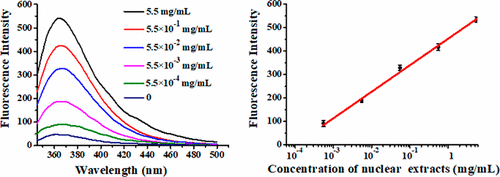当前位置:
X-MOL 学术
›
Anal. Chem.
›
论文详情
Our official English website, www.x-mol.net, welcomes your
feedback! (Note: you will need to create a separate account there.)
Sensitive Detection of Transcription Factor in Nuclear Extracts by Target-Actuated Isothermal Amplification-Mediated Fluorescence Enhancement
Analytical Chemistry ( IF 6.7 ) Pub Date : 2017-09-21 00:00:00 , DOI: 10.1021/acs.analchem.7b02451 Yan Zhang 1 , Dongxue Xiang 1 , Bo Tang 1 , Chun-yang Zhang 1
Analytical Chemistry ( IF 6.7 ) Pub Date : 2017-09-21 00:00:00 , DOI: 10.1021/acs.analchem.7b02451 Yan Zhang 1 , Dongxue Xiang 1 , Bo Tang 1 , Chun-yang Zhang 1
Affiliation

|
Transcription factors (TFs) modulate the process of gene transcription by binding to specific DNA sequences, and their alteration may cause a variety of diseases. Here, we develop a simple and sensitive method to directly detect TF in crude nuclear extracts using target-actuated isothermal amplification-mediated fluorescence enhancement with fluorescent base 2-aminopurine (2-AP) as the fluorophore. In the presence of TF, its specific binding to the probe prevents the digestion of the probe by exonuclease III (Exo III), initiating the extension reaction to produce DNA duplexes which may be subsequently digested by λ exonuclease to release single-stranded DNAs (ssDNAs) and free 2-AP molecules. Although some excess probes may be partially digested by Exo III, the phosphorothioate modification between two binding sites of the probe may generate a hindrance to preserve the rest of TF-binding probes which may hybridize with the released ssDNAs to initiate new cycles of nicking–digestion–hybridization, generating abundant free 2-AP molecules for significant fluorescence enhancement. Different from the reported amplification strategies, all the TF-binding probes take part in the amplification reaction no matter if they bind with TF or not, greatly improving the detection signal. This method can be used for sensitive detection of NF-κBp50 with a detection limit of 4.11 × 10–4 mg/mL and the screening of potential TF inhibitors as well. Importantly, this method is very simple without the involvement of any external quenchers, extra primers, and templates, and it may be extended to selectively detect various DNA-binding proteins by simply changing the binding-site sequences of the probes.
中文翻译:

目标致动等温放大介导的荧光增强灵敏检测核提取物中的转录因子。
转录因子(TFs)通过与特定的DNA序列结合来调节基因转录过程,其改变可能导致多种疾病。在这里,我们开发了一种简单而灵敏的方法,可以直接检测粗核提取物中的TF,方法是使用靶标激活的等温扩增介导的荧光增强剂,以荧光碱基2-氨基嘌呤(2-AP)为荧光团。在TF存在下,其与探针的特异性结合阻止核酸外切酶III(Exo III)对探针的消化,从而引发延伸反应以产生DNA双链体,随后可被λ核酸外切酶消化以释放单链DNA(ssDNAs )和游离的2-AP分子。尽管Exo III可能会部分消化掉一些多余的探针,探针两个结合位点之间的硫代磷酸酯修饰可能会产生障碍,以保留其余的TF结合探针,这些探针可能会与释放的ssDNA杂交以启动切刻-消化-杂交的新循环,从而产生大量的游离2-AP分子,从而显着荧光增强。与已报道的扩增策略不同,所有TF结合探针无论是否与TF结合均参与扩增反应,极大地改善了检测信号。该方法可用于检测极限为4.11×10的NF-κBp50的灵敏检测。与已报道的扩增策略不同,所有TF结合探针无论是否与TF结合均参与扩增反应,极大地改善了检测信号。该方法可用于检测极限为4.11×10的NF-κBp50的灵敏检测。与已报道的扩增策略不同,所有TF结合探针无论是否与TF结合均参与扩增反应,极大地改善了检测信号。该方法可用于检测极限为4.11×10的NF-κBp50的灵敏检测。–4 mg / mL以及潜在的TF抑制剂的筛选。重要的是,该方法非常简单,无需任何外部淬灭剂,额外的引物和模板,并且可以扩展为通过简单地改变探针的结合位点序列来选择性地检测各种DNA结合蛋白。
更新日期:2017-09-21
中文翻译:

目标致动等温放大介导的荧光增强灵敏检测核提取物中的转录因子。
转录因子(TFs)通过与特定的DNA序列结合来调节基因转录过程,其改变可能导致多种疾病。在这里,我们开发了一种简单而灵敏的方法,可以直接检测粗核提取物中的TF,方法是使用靶标激活的等温扩增介导的荧光增强剂,以荧光碱基2-氨基嘌呤(2-AP)为荧光团。在TF存在下,其与探针的特异性结合阻止核酸外切酶III(Exo III)对探针的消化,从而引发延伸反应以产生DNA双链体,随后可被λ核酸外切酶消化以释放单链DNA(ssDNAs )和游离的2-AP分子。尽管Exo III可能会部分消化掉一些多余的探针,探针两个结合位点之间的硫代磷酸酯修饰可能会产生障碍,以保留其余的TF结合探针,这些探针可能会与释放的ssDNA杂交以启动切刻-消化-杂交的新循环,从而产生大量的游离2-AP分子,从而显着荧光增强。与已报道的扩增策略不同,所有TF结合探针无论是否与TF结合均参与扩增反应,极大地改善了检测信号。该方法可用于检测极限为4.11×10的NF-κBp50的灵敏检测。与已报道的扩增策略不同,所有TF结合探针无论是否与TF结合均参与扩增反应,极大地改善了检测信号。该方法可用于检测极限为4.11×10的NF-κBp50的灵敏检测。与已报道的扩增策略不同,所有TF结合探针无论是否与TF结合均参与扩增反应,极大地改善了检测信号。该方法可用于检测极限为4.11×10的NF-κBp50的灵敏检测。–4 mg / mL以及潜在的TF抑制剂的筛选。重要的是,该方法非常简单,无需任何外部淬灭剂,额外的引物和模板,并且可以扩展为通过简单地改变探针的结合位点序列来选择性地检测各种DNA结合蛋白。











































 京公网安备 11010802027423号
京公网安备 11010802027423号